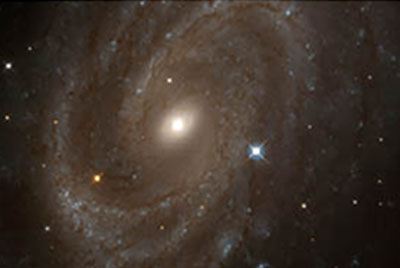Hubble Space Telescope image of spiral galaxy NGC 4603. It is the most distant galaxy with Cepheids used to measure the Hubble Constant.
Click on image for full size
NASA
Scientists Find the True Hubble Constant!
News story originally written on May 26, 1999
Scientists have found the real Hubble Constant after 8 years of research. The Hubble Constant is the rate that the Universe is expanding at. They found it to be 70 kilometers per second per megaparsec.
The constant is used to find the age of the Universe. Scientists say the Universe is 12 billion years old. That's a long time!
Special stars called Cepheid variable stars were used. Scientists can use them to find distances between galaxies. The Hubble telescope was named after Edwin Hubble, the first to believe the Universe is expanding.
You might also be interested in:

The Hubble Space Telescope (HST) is really neat! It was first launched in 1990, but scientists started building it in the 1970's! We have found all kinds of objects like stars, nebulae and galaxies. The
...more
It was another exciting and frustrating year for the space science program. It seemed that every step forward led to one backwards. Either way, NASA led the way to a great century of discovery. Unfortunately,
...more
The Space Shuttle Discovery lifted off from Kennedy Space Center on October 29th at 2:19 p.m. EST. The sky was clear and the weather was great. This was the America's 123rd manned space mission. A huge
...more
Scientists found a satellite orbiting the asteroid, Eugenia. This is the second one ever! A special telescope allows scientists to look through Earth's atmosphere. The first satellite found was Dactyl.
...more
The United States wants Russia to put the service module in orbit! The module is part of the International Space Station. It was supposed to be in space over 2 years ago. Russia just sent supplies to the
...more
A coronal mass ejection (CME) happened on the Sun last month. The material that was thrown out from this explosion passed the ACE spacecraft. ACE measured some exciting things as the CME material passed
...more
Trees and plants are a very important part of this Earth. Trees and plants are nature's air conditioning because they help keep our Earth cool. On a summer day, walking bare-foot on the sidewalk burns,
...more















